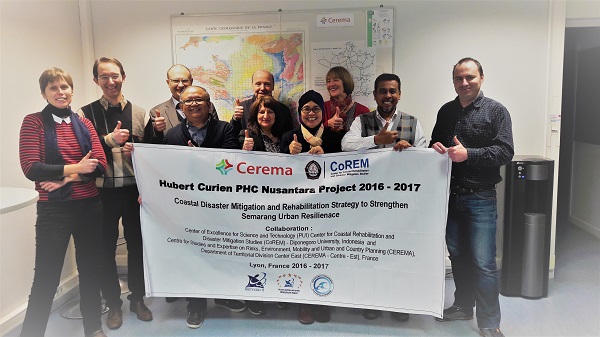
Semarang is a coastal city on the Indonesian island of Java, with a population of almost 2 million people. It is subjected to major marine submersions owing to a combination of two phenomena: rising sea levels, and subsidence. The subsidence here takes the form of landslips of up to 14cm per year in some parts of the city.
Predicting and planning for natural risks
In 2013, the French Embassy in Indonesia asked Cerema to provide support with planning a Franco-Indonesian convention in Sumatra on the topic of natural hazards. And so, in response to a request from the French Embassy, Cerema travelled to Java where it was able to observe the various problems caused by natural hazards, including subsidence in Semarang.
The subsidence, also known as landslipping, is caused by the fact that Semarang is built atop recent sediment that is still undergoing the compaction process. This is only made worse by human activity. There are 10-14cm of landslip every year depending on the area, and along the coastal margin in particular. At the same time, sea levels are rising by an average of 1cm every year. This means that the coastal margin is subjected to frequent marine submersions, affecting between 200,000 and 600,000 people, especially when heavy rain coincides with a tide.
In some neighbourhoods, residents find themselves stuck in homes with 10cm of water, especially during high tides. The problem first appeared with the burgeoning urban development that began in the late 1980s. It is estimated that Semarang's population will triple within the next 20 to 30 years, so careful thought must be given to the area’s planning and development, with a view to more sustainable, long-term development.
A resilience-based approach

Cerema is working to develop local resilience to natural hazards linked to subsidence. To do so, it is opening channels between UNDIP university and local decision-makers, so that scientific knowledge of natural hazards can find practical applications.
Thus, in 2013 Cerema signed a partnership with Diponegoro University (UNDIP) in Semarang – still under the aegis of the French embassy – to begin work on bolstering the city’s resilience.
It is of vital importance for Semarang, in a context where subsidence is worsening year on year, with increasingly severe consequences for the local population, economy, and environment. This resilience-based strategy is particularly effective because it makes it possible to predict and take into account the future situation, so that we can adapt regional planning to the challenges of the future.
Initially, this partnership enabled us to observe and understand the factors behind the hazards and how they interact, and to develop a systemic model of how Semarang should proceed with regard to these risks of subsidence, submersion, and landslips. Next, we created an action plan, one of the pillars of which was the creation of a subsidence watchdog.
Then a new project, in continuation of the initial work, was put forward. It was conducted as part of a Hubert Curien Partnership[2] – PHC Nusantara 2016-2017 – between Cerema and UNDIP, backed by the French and Indonesian ministries of foreign affairs and research. The Coastal Disaster Mitigation and Rehabilitation Strategy to Strengthen Semarang Urban Resilience project will outline the characteristics of this watchdog, which forms the keystone of the resilience-based strategy.
The subsidence watchdog will unite and raise awareness among the various stakeholders, and compile both local and international knowledge and experience. It will present relevant action that could be taken, like adapting housing and transport infrastructure to live with subsidence. The watchdog will also provide insight into the problems that come with pumping groundwater, the effects of deforestation, protection against submersion, and restoration of the protective mangroves, etc.
The ultimate aim is to support local authorities in taking subsidence into account in their planning and actions, to help them assess the range of protective structures available to them, and to understand them as part of a comprehensive, systemic overview.
The project’s Indonesian partners visit Cerema

To finalise this PHC project, the Indonesian partners from UNDIP travelled to Cerema in December 2017. Ms. Ita, international relations manager at UNDIP, Mr.Helmi, director of the Center for Coastal Rehabilitation and Disaster Mitigation Studies Corem, and Mr. Josup, a marine sciences researcher, received a warm welcome from their colleagues at Cerema Centre-East. It was also an opportunity to visit the soil mechanics lab facilities for subsidence, and to present Cerema’s tools and methods for monitoring ground movements during a tour of the unstable Séchilienne site.
In late 2018, Cerema published a report in French and English providing feedback on the Cerema-UNDIP partnership through the lens of the city of Semarang.
Now, the project members are aiming to get the watchdog up and running, and hope that the local authorities will take concrete action to make the area more resilient to the natural hazards caused by subsidence.
[1] Cerema Territoires et Ville and Cerema Centre-Est
[2] Hubert Curien Partnerships (PHC) are part of a policy to support international scientific and technological exchanges from the French Ministry of Europe and Foreign Affairs, and are implemented with support from the Ministry of Higher Education, Research and Innovation.

